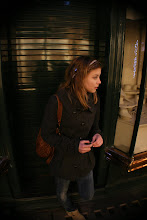A few pictures of the 'making of'.

My cat seemed to be very interested... But even more so in the final hanging monsters.


A2 Practical Production





A monster is any type of legendary creature which usually appear in legend or horror fiction. The word monster derives from the latin word monstrum, meaning omen, from the root of monere("to warn") and also meaning "prodigy" or "miracle".The term monster refers to a being that is a gross exception to the norms of some ecosystem. A person referred to as a monster is taken as exceptionally evil, grotesque, unreasonably strict and uncaring, sociopathic, and/or sadistic. The word monster connotes something wrong or evil.
This definition can be associated with so many things other than Godzilla and Frankenstein. The second part of the definition is an exact description of Lilly's father. A story/film that comes to mind that does not use the stereotypical monster name to large creatures destroying cities is the movie "Monster". In this movie, Charleze Theron plays a lesbian prostitute who due to some unfortunate events begins killing her clients. This movie, like ours, shows a different side of the 'monster' definition.
Here is a link to the top 10 movie monsters. (Godzilla included!)
Cinemassacre's Top 10 Giant Movie Monsters
After thinking and reading about monsters I came up with a great shot that we could use for our opening scene. This would help us tie in the monster theme. I found a video online teaching you how to make "Monster Origami Masks". The shot I have in my mind sets in a classroom that is filled with crafts done by the children. The craft focus of the shot is the monster origami masks that are hanging from the ceiling on strings. They are light and therefore swing and twirl in the breeze. All different colors are present. If we open with a close-up shot of these hanging masks (that the kids supposedly have created before in a classroom project) it sets the mood for a 'monster' theme. They seem innocent and fun, yet they represent a whole lot more- which is found out throughout the duration of the film. During this shot, the title of Monster would appear on the screen.
Monster Origami Mask



Red Rose Killer
Treatment #1
The story stars out as a clip based in olden times. This can be deciphered through the date on the bottom corner of the screen, as well as the granulled old style filming. The voice on the radio speaks of a third murder by the mysterious ‘red rose killer’ who leaves a red rose at the scene of his every killing. The voice on the radio also describes the targets as young, attractive women. As someone turns the radio off the scene fades into current day with the effect of granulled type film being taken off as well as the text ‘current day’ in the bottom corner being displayed. We are then seeing an older man distressed in his sleep. He is shaking and mumbling. At this time there are flashbacks of scenes of murder- this is to represent what the man is dreaming about. The scene cuts from the dream to reality a few times until finally the man wakes up. There is no diagetic dialogue as music covers the man’s voice. He picks up the phone dials a number and then speaks into the telephone (we cannot hear his voice). There is a cut to an analog clock. A fast forward affect of the clock turning quick lets the audience know a long time has past- even though it has only taken up a few seconds of the clip.
Afterwards, we see a women walk into the room. Her dialogue reveals that she is the man’s dead wife’s sister. They have not spoken since the death of Lily (sister and wife). The man seems to be in painful agony (coughing, speaking uneasy). He tells the sister that he has a confession to tell her. As he starts telling his story he pulls out a letter and describes it as the beginning of everything. There is a flashback of a woman writing this letter. His wife is the one writing to him to confess her unloyalty to her husband. She narrates the letter as she writes it, folds it up, and puts the letter on his pillow, followed with a red rose on top of the letter. The continuation of the film happens with a large amount of flashbacks and flash forwards into current time. The man confesses that he has killed his wife as well as 3 other women due to the rage and anger he had acquired from being cheated on. The clips of him killing the other women are tastefully shown with flashbacks of hints of killing and seduction. As the women he was after were unloyal women, just like Lilly. He confesses his killings to the sister. She is obviously very distressed and didn’t know what to think of it all. Before she has time to put her input into the tragedy of her sister and those women, the main character dies. She places one white rose on top of him as there was a vase with white roses next to his bed. This concluded the film with a quote from the bible talking about clearing away your sins, and red turning into white. “Though your sins be as scarlet, they shall be as white as snow.”
